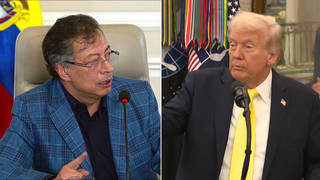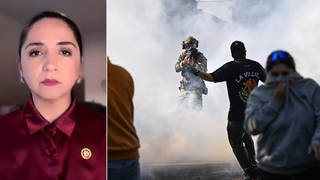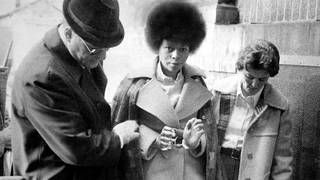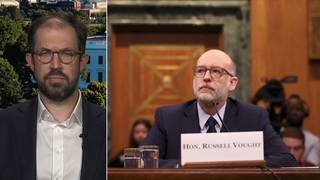
Buoyed by a convincing triple victory in yesterday’s primaries, Republican presidential contender George W. Bush has now turned his sights to next week’s pivotal Super Tuesday elections, when his party’s nomination could be decided. Bush beat Arizona Senator John McCain by large margins in Virginia, Washington and North Dakota. [includes rush transcript]
Meanwhile, in the Democratic race, Vice President Al Gore dealt a devastating blow to former Sen. Bill Bradley, beating him in a non-binding vote in Washington, where Bradley had made an all-out effort for victory.
Next Tuesday’s primaries will take place in some of the nation’s largest states, including several that have large non-white populations, such as California and New York. The Latino vote has become increasingly significant in U.S. elections, particularly in the last few years, when scores of immigrants became U.S. citizens as a result of new stringent immigration laws that cut back the rights of both undocumented immigrants and permanent residents.
Within the next decade, Latinos will become the largest minority group in the United States, and by the year 2050 they will comprise one quarter of the population. And today, we look at their history, political significance and contribution in the U.S. through a new book by Democracy Now! co-host Juan Gonzalez, Harvest of Empire: A History of Latinos in America.
Guest:
- Juan Gonzalez, Co-host of Democracy Now! and author of Harvest of Empire: A History of Latinos in America.
Transcript
AMY GOODMAN: Oh, by the way, welcome, Jazz, into the world. Well, we’ll being talking about music later, but I’m talking about Jazz. It was music to my ears earlier this morning when I got a call that Jasper George Goodman was born to my brother David and my sister-in-law and dear friend Sue. We also have another birth to celebrate, and that is Sesa Lisa Scahill, born to Jeremy and Ivana. Jeremy Scahill was a reporter at Democracy Now! and former producer. So Jazz and Sesa, welcome.
JUAN GONZALEZ: Amy, that’s five times an aunt now you are?
AMY GOODMAN: An aunt, that’s right. It’s official. Juan also recently had a baby. How’s Gabriela doing?
JUAN GONZALEZ: She’s fine. She’s fat and sassy right now.
AMY GOODMAN: How old?
JUAN GONZALEZ: Eight months. Eight months.
AMY GOODMAN: Well, I’m amazed you had the time for both having Gabriela and also giving birth to a book, because today it is all in the family, folks, as we talk about Juan Gonzalez’s new book, called Harvest of Empire: A History of Latinos in America, particularly relevant today, as we move into next week, Super Tuesday’s primaries.
Again, just a recap of what happened yesterday around the country, in Virginia, North Dakota, Washington State. In Virginia, Bush had more than 350,000 votes — that’s 53 percent — versus McCain’s 44 percent. Yes, Alan Keyes is still in the race at three percent. Virginia was an open-to-all primary, but Republicans cast two-thirds of the vote and rallied overwhelmingly to Bush, as they have in earlier contests.
In North Dakota, with all districts reporting, Bush had 76 percent of the vote. That’s more than — close to 7,000 votes, and McCain had 1,700 votes, or 19 percent. Keyes had five percent.
In Washington State, it looks like Bush had about 58 percent, McCain 38 percent, Keyes two.
And then, of course, there was Bradley and Gore. Bradley, in the Democratic side, the former senator from New Jersey, spent five days in Washington State campaigning for at least a strong showing in the primary and a boost into next Tuesday. Instead he suffered his fourth loss. Gore won 56 percent to Bradley’s 31 percent. And he plans a five-minute national TV ad Thursday night on CBS, but even before the setback there was speculation he might drop out, though his spokesperson denies it.
That’s what we have in the last day, and now there’s next week, Super Tuesday, major states where Latino voters could be decisive. In the next two weeks, on March 7th and March 14th, we’re talking about states like California and New York, and the following week Texas and Florida. Actually, Juan, you’ll be in a number of these states over the next few weeks as you go around being interviewed on your book, and I’m really thrilled to be able to talk to you about it today, Harvest of Empire: A History of Latinos in America.
Juan, talk about these voting blocs that have only recently begun to get attention. Talk about the Latino population in states like California and New York.
JUAN GONZALEZ: Well, it’s not just in those states, amazingly enough, because some of the other states that will be voting also, for instance, next Tuesday are Connecticut, which has huge Latino populations in all the major cities of Connecticut, Massachusetts, which has a growing — fast-growing Latino population. You’ve also got Ohio, and of course Texas and Florida on the 14th are the biggest in terms — second to California in terms of the large percentage of Latinos.
But, you know, the amazing thing is, as I try to document in one chapter of my book on sort of a history of Latino political involvement since World War II, is that 50 years ago the number of registered Latino voters in this country was in the thousands, and today it’s more than 6.5 million, and that 50 years ago there were only a few hundred Latino elected officials at any level anywhere around in the country. Today there are more than 6,500, and still it’s a small percentage compared to the overall proportion of the Latino population of the United States.
But there has literally been an explosion of Latino — not just of the population, but of Latino voting power, so that you have a situation where for the first time you’ve got the two leading candidates of both parties for the nomination, Gore and Bush, like to boast about their ability to speak in Spanish. Although I understand Gore just turned down a request by Univision to do a full interview in Spanish. He said he used to be fluent, so I guess that he can only do it when he’s rehearsed exactly what he’s going to say beforehand.
But I think, more importantly, certainly in terms of the Republican strategy, it’s clear that whether it’s Bush or McCain, they’ve pretty much given up on the possibility of being able to make any dent into the African-American vote in the country. Certainly their failure to say anything about the Confederate flag in South Carolina, Bush’s visit to Bob Jones University, emphasizes that even more. But there is this suspicion and this strategy that the Bush people keep pressing that they can make significant inroads into the Latino vote in places like California and Texas and Florida, and thus recreate something that has only happened during Reagan’s — the Reagan era, when Latinos voted for Reagan about 35 to 40 percent, as opposed to the normal 20 percent that they had for other Republican candidates. So they’re basically hoping to make enough of a dent into this growing Latino vote to be able to build a kind of coalition that’ll get them into power in November. The problem is that they first have to get to the candidacy of the parties.
AMY GOODMAN: Juan Gonzalez. You know him as co-host on Democracy Now! He is a New York Daily News columnist here in the city where we broadcast from. He also has won numerous honors, including the 1998 George Polk Award for Excellence in Journalism and the Hispanic Academy of Media Arts and Sciences Lifetime Achievement Award. He was born in Puerto Rico, grew up in a barrio housing project, and was co-founder in the 1960s of the Young Lords.
Juan, you talk about the Latino voting bloc, but what’s so powerful about your book is that you break down that Latino bloc or the populations around the country, and you talk about who Latinos are, where they come from.
JUAN GONZALEZ: Yeah, I think that clearly one of the difficulties that many people have had in trying to look at the Latino community is that there are so many different ethnic groups within the Latino community, or national groups. In the book, I try to deal not just with what we call the Big Three, which would be the Mexican-American, Puerto Rican, and Cuban-American communities, but I also take —
AMY GOODMAN: Those are the largest populations?
JUAN GONZALEZ: Those are the largest. Yeah, basically, you’re talking about the Mexican-American community represents about 60 percent of all the Latinos in the United States, so it’s by far the largest. And then the Puerto Rican community comes next, and then the Cuban community.
But the real story has been the fast-growing nature of the other Latino groups: Dominicans, Colombians, Nicaraguans, Salvadorans, Hondurans, and even folks from Peru and Ecuador. And the explosion of this multinational Latino presence in the United States is really a relatively new phenomenon, basically dating from the 1980s. And I document in the book, for instance, how at the beginning of the 1980s there were fewer than 100,000 Salvadorans living in the United States, and by the end of the 1980s there were close to a million. There had been a huge, huge population explosion of Salvadorans, as there was of Nicaraguans, largely as a result of the civil wars that were occurring in those countries at the time. And, of course, the Dominican population in the East Coast of the United States has exploded significantly, so that I believe that it’s very possible that when the new census, for instance, in New York City occurs, there will be almost as many Dominicans in New York as there are Puerto Ricans, and — because of just the numbers of Dominicans that are coming every day.
And one of the things I try to make clear, because people say, ” Well, if there are so many different nationalities, then they all have different political orientations, and they’re very much like other European immigrants.” But I think one of the things that happened with the massive Latino migrations after World War II was that Latinos didn’t — because of the particular racial and linguistic history of the United States, Latinos did not become just another series of immigrants moving up the immigrant ladder, but they actually became a linguistic caste in the United States, and that — because what binds all of the different Latino groups together is that they all speak Spanish, and therefore have much more of a cultural bond between them than they do with the rest of the United States.
And one of the things that’s most important in terms of understanding U.S. history is that the linguistic history of the United States has been one that does not — that has attempted to stamp out diversity of language, to the point of view, for instance, that most of the major international — like the U.N. Declaration of Human Rights, most international law recognizes not just the right of a people to be free from discrimination on the basis of race or nationality, but also of language, whereas the courts in the United States have never recognized the right of people not to have discrimination based on language, so that what has happened is the United States courts have allowed linguistic discrimination to continue to occur in the country, and that has been felt by all Latinos, no matter what nationality they’re from, and in essence has bound them together in a way that they weren’t even as close when they were in their own home countries, but in this country they’ve been thrust into this linguistic caste status.
And so, I attempt to look at that history, and — because people say, “Well, are Latinos a racial group? Are they an ethnic group?” Well, depending on the Latino group, there are people of all races within those groups, and some are more African than others, some are more Indian than others. But all have fallen into the linguistic caste structure of the United States, and I think that that has had an amazing impact in terms of the — so that you find Cubans and Puerto Ricans, who may disagree on a whole host of political issues, all agree that they suffer discrimination because of their language and culture in this country.
AMY GOODMAN: By the year 2050, just in 50 years, one out of every five U.S. residents will be of Hispanic origin. Juan, Amazon.com and —
JUAN GONZALEZ: No, that’s actually one out of every four.
AMY GOODMAN: One out of four?
JUAN GONZALEZ: Yes, the projections of the U.S. Census Bureau, the midterm projections — in other words, they’re not the most dramatic — postulate that by 2050, there will be approximately 400 million Americans — right? — and of those 400 million, 100 million will be Latino.
AMY GOODMAN: Well, I got the figure from Amazon.com, so I’ll ask you if the second part is accurate, when they say, “A leading Hispanic journalist” — and that’s not for you to decide, but I agree — “A leading Hispanic journalist’s radical new perspective on the intertwined heritage of America and Americanos and how today’s exploding Latino population in the United States is a direct result of our government’s past policies toward Latin America.” They’re talking about your book, Harvest of Empire: A History of Latinos in America. How does the reason people come to this country, and if it is a direct result of our government’s past policies toward Latin America, shape Latinos’ political view?
JUAN GONZALEZ: Yeah, that’s one of the main thrusts of my book, I think, that I think separates it from the dozen or so books that have come out in the last decade looking at the Latino community, is that I believe that there is a direct relationship. If people ask, “How come more than 50 percent of all of the immigrants to the United States since World War II have come from Latin America? Why is that? Why are so many Latinos in this country?” you know, unless you go back to each of the major countries that supply the Latino immigrant population and understand what was happening in those countries to force so many people to leave at once, then you won’t really get a good understanding.
And it’s my thesis that the penetration of Latin America by American businessmen, military, and in the 19th century and the early 20th century, the deformation of the economies of those countries, set the basis and actually created the mass migration, and that, for instance, you do not find large numbers of Argentinians in the United States. You do not find large numbers of Chileans in the United States. You do not find large numbers of Uruguayans in the United States. But the immigrants, the largest source of immigrants, Latino immigrants, to this country are precisely from those countries that were most dominated and controlled by the United States, the Caribbean Rim nations, and that’s from all of Central America and Mexico, Colombia, and then the Dominican Republic, Puerto Rico and Cuba. That is the source. The most dominated countries are the ones that have produced the largest number of immigrants to the United States.
And so, and I try to document how there was actually — there was an enormous attempt to create — to have Latinos satisfy labor needs, and much of the early migration was direct recruitment of companies that would try to get Latinos to come here to be able to provide labor. For instance, the Southern Pacific Railroad, when it was building the railroads in the Southwest, contracted 16,000 Mexicans to come over to build the railroad. Henry Ford and the Ford Motor Company recruited thousands of people, of Mexicans, to come to Detroit. Bethlehem Steel, for instance, recruited large numbers of Mexicans to go to Bethlehem, Pennsylvania, to work in the steel mills, and there’s a huge Mexican-descended population in Bethlehem, Pennsylvania. That many of the small towns, where you had — where you have now these small, out-of-the-way towns, where you have huge Latino populations — Kennett Square, Pennsylvania, as an example, Vineland, New Jersey. You go — Haverstraw, New York. All of these small towns that have huge Latino populations, most of them came as a result of direct labor contracting by farm interests.
And now, for instance, you have this huge explosion of Latinos in the Midwest. I’ll give you an example. In 1998, Latinos were an estimated 33 percent of the residents of Dalton, Georgia, 45 percent of Lexington, Nebraska, 40 percent of Dodge City, Kansas. These Midwestern states, especially, have huge Latino populations, because the meat-packing industry has been, over the last 10 years, intensively recruiting Latinos to come and work basically in the two-tier wage structures that they’ve set up for many of these unions. So you have the older white workers in the meat plant still at the higher tier of wages, and now they’ve created a low or basically minimum wage situations, where they recruit basically Mexicans and others from other parts of the country — from other parts of Latin America to come and work in the meat-packing plants. So that what has happened in essence is this huge creation of a caste — a Latino caste status within the American labor movement, in large part directly recruited by companies to come and work.
AMY GOODMAN: We’re talking to Juan Gonzalez, and his new book is Harvest of Empire: A History of Latinos in America. When we come back, I want to ask you about the Latinos in California and next week’s Super Tuesday primary. And then we’re going to look at the cultural response to the Amadou Diallo killing and the verdict and its aftermath. We’ll be speaking with a musician and listening to some of his work. You’re listening to Pacifica Radio’s Democracy Now! We’ll be back in a minute.
[break]
AMY GOODMAN: You are listening to Pacifica Radio’s Democracy Now! I’m Amy Goodman, here with my co-host Juan Gonzalez, who is not a new author. This isn’t his first book. He had a collection of his columns published as a book a couple of years ago called Roll Down Your Window: Stories of Forgotten America. And now his new book, that has just been published by Viking Press, is A History of Latinos in America. And Juan, we don’t even have time to go back the centuries you go back. This is a very rich book, and I hope to continue this conversation on Friday, when you’re back. But on the issue of Latinos in California?
JUAN GONZALEZ: Yeah, well, California of course is the — at this point is the mother state in terms of Latinos in America. Not only is it the largest state in the United States, it also has the largest Latino population. Close to about 30 percent of the population of California is Latino. And it will probably be the first state that is majority Latino in the United States. And you’ve got an enormously varied population there, not only Mexican American, which is by far the largest, but you have a huge Salvadoran population, Honduran population, and also you have — there’s always been a large Puerto Rican population in places like Hayward and — Hayward, California, and in the Los Angeles area.
And clearly, one of the things that the — one of the big problems that the Republican Party has faced is that the anti-immigrant position of the early ’90s had an enormous backfire, because, you know, for instance Mexicans — most Mexicans who came to this country never became citizens until about 1995, because most had the hope of eventually returning to Mexico, and so there was a very low naturalization rate among Mexicans. Something like three out of 10 were actually becoming citizens. However, as a result of Proposition 187 and then of course the 1996 laws that the Republicans pushed through Congress basically cutting off benefits even to legal immigrants, what happened is they forced all of these people who were in the country as legal residents but had never thought of becoming citizens — they had no choice but to become citizens if they wanted to continue being in the country.
So what has happened since 1995 has been an enormous rush to citizenship in the Latino community. And all of these folks, basically scared to death that they were going to be ostracized or lose some benefits, ended up rushing to become citizens. You’ve had the largest push for citizenship in U.S. history in the last three or four years. And as a result, they all registered — and most of them registered as Democrats, because they saw the Republicans as the people who were creating problems for their — the quality of their lives. And that’s why Bill Clinton won such an enormous percentage of the Latino vote in 1996, and that’s why the Republicans almost lost the House in the last midterm elections, and that’s why the Republican Party, as represented by George Bush, has been seeking now to get away from that anti-immigrant image and try to recapture some of those Latinos, especially the more prosperous ones, in places like California and Texas.
AMY GOODMAN: Well, Juan, we’re going to wrap up this discussion now but continue on Friday talking about Latinos in America and your new book, Harvest of Empire, as you talk about the roots, conquerors and victims, the image of America forms, the Spanish borderlands, and the making of an empire, the banana republics, and bonds taming the empire’s backyard. You’re getting a very good review in the New York Times Book Review this weekend, and we forgive you for that, but the criticism is that you find — is you don’t find too much good to say about the U.S.
JUAN GONZALEZ: Yes, that’s what I’ve seen, and also that I’m too hard on the free trade policies of the United States.
AMY GOODMAN: And we’ll talk about the effect they have had on Latinos in America. Juan Gonzalez’s new book, Harvest of Empire, is published by Viking, and he’s headed out to the West Coast, where we’ll be co-hosting — he’ll be co-hosting Democracy Now! from places like San Francisco, where he’ll be on Monday, and then Houston and San Antonio on Tuesday and Wednesday. And by the way, folks, on our website, you’ll be able to see where Juan will be speaking in different places. I’m very relieved, Juan, that in San Francisco, when you speak on — is it, what day?
JUAN GONZALEZ: It’s Monday night.
AMY GOODMAN: On Monday night, that you’ll be speaking in A Clean, Well-Lighted Place.
JUAN GONZALEZ: Right, that’s the name of the bookstore, yes. We’re all trying to stay out of the dim light these days, you know?
AMY GOODMAN: Speaking of which, this is a perfect segue into our last segment. You did a column yesterday on Amadou Diallo called “Carry Wrong Wallet? Not on Your Life.” Maybe you can read a little part of it before we introduce our next guest.
JUAN GONZALEZ: Yes. Well, the column starts out:
I went shopping for a new wallet yesterday afternoon on Westchester Ave. in the Bronx.
The old wallet was in fairly good condition, and I had become accustomed to the soft, worn leather in my back pocket. But familiar or not, it had to go.
It was, you see, a black wallet — much too dangerous to carry these days around the inner city.
I stopped at Jack’s Discount, which is a few blocks away from where Amadou Diallo once lived. Jack’s is one of those places that sells everything from Roach Motels to living room sets. But not wallets.
At a tiny stall outside, a young black man was hawking knit caps, gloves and scarves. At the back of the stall were several small stacks of men’s wallets.
“Let me see those,” I said.
“Five dollars,” the young man said in an accent I couldn’t quite place.
The stack, however, was mostly black. Men’s wallets have never been fashion statements.
“Any other colors?”
He pulled a lone dark brown from the bottom of one pile. I frowned. He plucked a dark blue from the bottom of another pile.
“No good,” I said. “You heard of Amadou Diallo?”
“Amadou!” he said. His words sounded like a war cry. “I don’t know from that.”
I pressed him for another color. From the bottom of the third pile he snatched up two light tan ones with an ugly crown pattern and the word “MARCA’S” stamped all over them.
That would have to do.
Around the corner from Wheeler Ave. was the Beeper Care Center. Black cell phones and black beepers are now another problem.
Maria Martinez was standing behind thick plexiglass in the store talking to a customer.
On display in the window were face plates for cell phones. There was a lime green plate and a flaming orange plate and a pink neon plate.
“How much for those?” I asked her.
“They’re 15, 20 or 30 dollars, depends on the phone and the brand of plate,” she said. “Nokias are the most expensive. Some customers buy different ones to match what they’re wearing.”
I asked about the beepers on display. They came in a dozen bright colors, even yellow.
“Same price in color or black,” Martinez said. “The kids prefer colors. Standard Telcom makes them. But the Motorola only come in black. They’re top of the line. Don’t need any color when you’re on top.”
And then I go on to talk about the scene in front of Wheeler Avenue and all the people that were coming in to leave flowers in the building, in the vestibule, where Amadou Diallo was shot, and say:
At one point, four elderly black women got out of a car. “Will you look at how small it is,” said Madge Smith, one of the four. She had come all the way from Sheepshead Bay in Brooklyn.
“How can you fire 41 shots into that tiny space?” Smith said. “Those jurors should have come here and seen for themselves. The poor man couldn’t run anywhere.”
They came and went all day, the anger and the hurt so deep many could not talk.
And so, then I go on to talk about some of the other people who went there. And finally, I end the column saying:
Those who expected rioting this weekend ended up relieved that only protest ensued. They do not understand the greatest fallout from Amadou’s death.
In the black and brown neighborhoods of the city — even among many whites — the faith no longer exists that ordinary citizens and police will be judged the same way by our legal system.
AMY GOODMAN: That’s Juan Gonzalez in the New York Daily News, and you can go to our website at www.democracynow.org, which links to Juan’s columns.












Media Options